Literary Adventures for Kids offers dozens of book clubs/novel studies for kids of all ages. The program is versatile enough to meet any English Language Arts requirements. You can purchase individual novel studies, bundles (thematic or yearlong), or a grade-specific membership that gives you full access to all book clubs for either grades k-8 or grades 9-12.
In this video, I give you an inside look into some of the book clubs our family has recently completed and share what we love about the program. You can find the video transcript below.
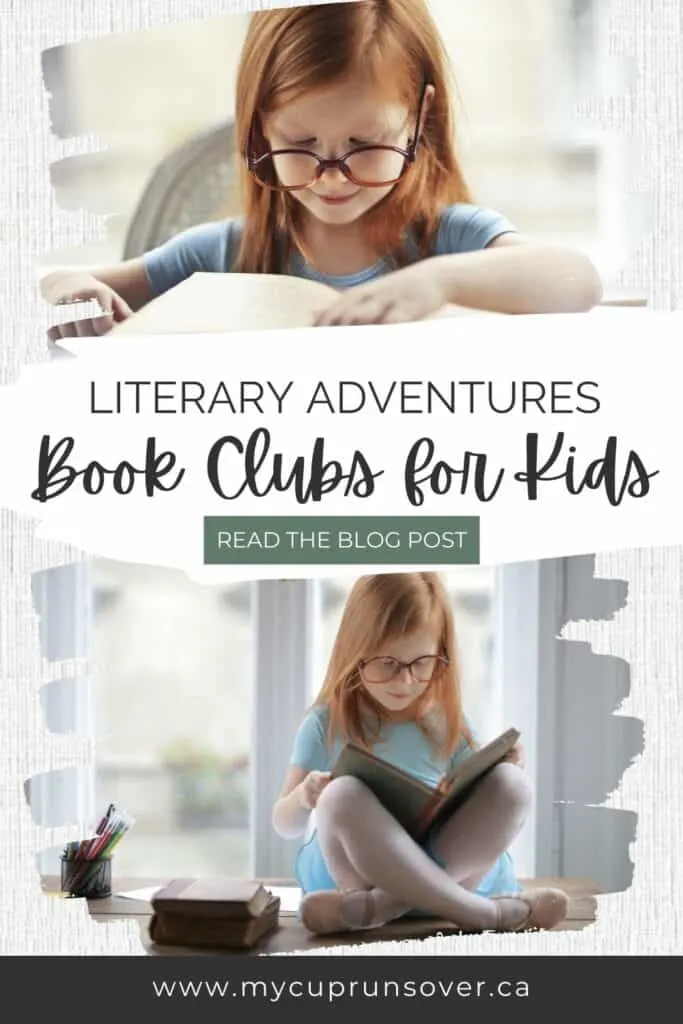
Affiliate disclosure: This post may contain affiliate links, which means we may receive a commission if you click a link and purchase something that we have recommended. Please read our disclaimer for more details.
Video transcript
Hey guys! Today, I’m going to give you an inside look at the novel study program that we are using in our homeschool for both elementary school and middle school. It’s called Literary Adventures for Kids, and it offers dozens of novel studies for everything from Dr. Seuss to Lois Lowry. And I’m going to give you a look inside some of the novels that we’ve been studying and why we love this program so much.
Literary Adventures for Kids is a collection of novel studies, and they can be purchased in different formats. You can purchase individual novel studies. They’re about $10 to $20 each. This screen here shows all of them. If you look at this list, you can see nature studies, poetry courses, planning courses, middle school books, upper elementary, high school, and then bundles.
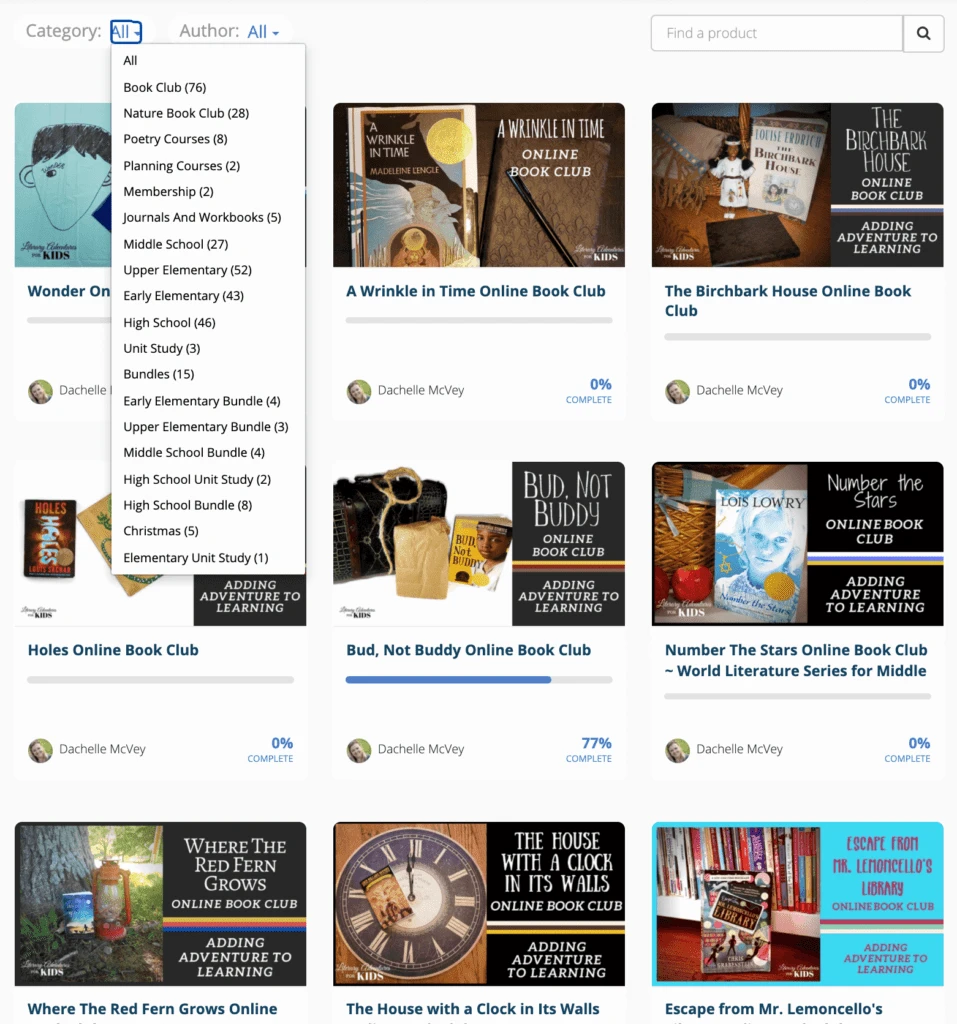
I actually have the subscription to the Literary Adventure Clubhouse, which I’ll tell you about in a second. It includes all of these books, such as Wonder, a Wrinkle in Time, The Birchbark House, Bud, Not Buddy Number the Stars. We got some Nancy Drew there, Dr. Doolittle, Brown Girl Dreaming. So, you can see there’s just a huge collection of books here and there’s individual books as well as bundles.
I wanted to show you what’s actually inside some of these novel studies because I think a novel study can look like a lot of different things. And in fact, here they’re actually called book clubs. And the idea is that you might do them in a group with either a homeschool co-op or an, an online book club. And when you subscribe to the membership program, they actually offer a live online book club.
I think there are five meetups and books per semester. So that’s a really cool addition that you can add on if you’re trying to build some more connection with other people into your homeschool.
I’m going to show you, we just finished Bud, Not Buddy, which is one of my daughter’s favorite books, and I’m going to go in there cause it’s the freshest in my mind.
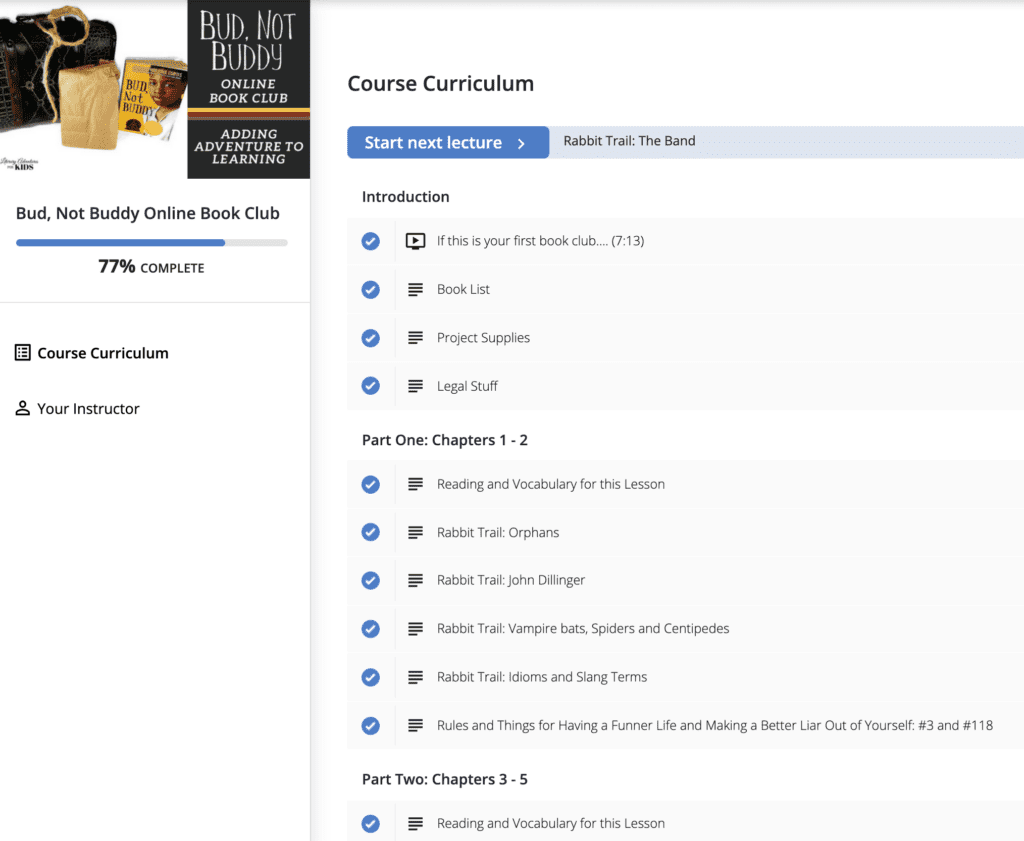
When you come into the book club, it always starts out like this. You have the little introduction video from Dachelle, the list of books that you’ll need, which is typically just the one book, and supplies for any projects that are going to be included. In this book club, there are four different projects. These are the supplies that you would need if you are planning to include those projects and you can see they’re super basic: paper, pen, flashlight, gold, marker crayon. Mostly things that you’re going to have on hand.
One of my favorite things about these book clubs is that they really move away from the idea that the only way to engage with literature is to answer questions about what you’ve read, do reading comprehension, or to write an essay in response to what you’ve read.
They make it fun so that kids enjoy reading the novels and they get a lot more out of it. The two ways they do that are through rabbit trails and magic dust. Rabbit trails are when you’re reading a book and somebody or something from history or pop culture is mentioned, and you’re like, I didn’t really know who that is, but I can sort of figure it out from the context of the sentence or the chapter here.
What they’ve done for us is they’ve actually put together resources on a lot of those people, topics, and themes that come up in the book so that we can sort of go down this rabbit trail of learning more about them.
In this book, Bud is an orphan, so we go down this rabbit trail of looking at what did it mean to be an orphan during this period of time? Why were there so many orphans and what was life like for them? In this case, there’s a little bit of explanatory text, and then there’s a couple of articles you can go and read.
And these are always external resources. Next, Bud runs into a vampire bat. So, we get the context from the book and then we get, again, some articles. I’m picking all the article ones here, but often they’re videos, which is really fun. My kids love watching the videos so they always want to do book club.
A lot of the time, if it’s like a person or a musician or something like that, you’ll get an embedded YouTube video of a music video or a speech or a clip from a documentary talking about that person’s life and I think that’s so fun for kids. I know my kids really engage with the video format more than say the articles or going and researching someone on their own.
It’s just easier for them. We’re not asking as much of them, but I think that they retain the knowledge equally well, and they’re having fun at the same time. And on the plus side, it doesn’t take as long. They don’t have to go and do the research on their own and, say, write an essay or a paragraph about somebody.
They just get to watch a fun video and appreciate a different time period or culture. And that’s not to say that there isn’t a time and a place for research and essays. Absolutely, there is. But I think the focus here is really on enjoying the novel and just getting as much of the richness out of it as you can, and not necessarily having to stop and write an essay about everything that happens in the book.
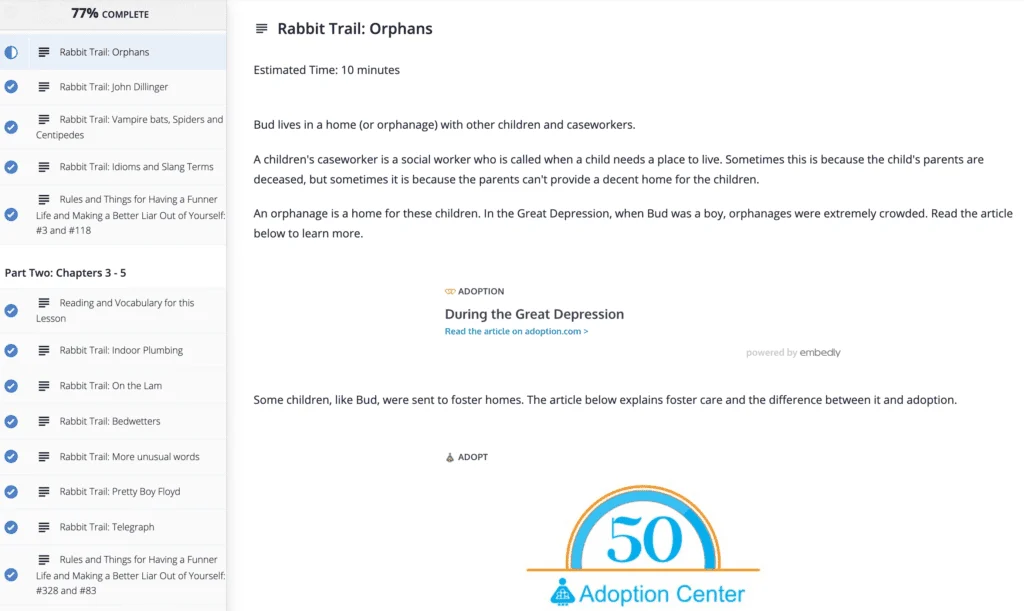
So, rabbit trails are just going down those little paths of things that are mentioned in the books. This was a fun one–public libraries. For example, we get the history of libraries and the importance of libraries. These are questions that kids might not think to ask on their own, but they’re really interesting topics to dive into together.
Why were libraries created? What role did they serve in their communities? And, and what role do they serve today? How important are they? And it just gives a completely different perspective than we might take just from reading the book.
Now, magic dust, that’s either a field trip or an outdoor activity or some kind of hands-on thing you’re going to do together. In this example, you are going to work on learning Morse code and making your own messages with Morse code, and playing a game.
I tend to do more projects with my younger kids than with my older kids, just because they’re more hands-on learners, but we just also finished Raindrop Plop! with my four- and seven-year-olds. In this book club, everything was related to weather. It was almost like doing a full unit study on weather based on this one little book.
We watched videos about clouds, rain, thunderstorms, tornadoes, hurricanes, freezing rain, blizzard, snow, all kinds of different weather. And then we got to do quite a few of the magic dust activities. For example, making a thunderstorm using a plastic container, red food coloring and ice cubes or making it rain.
We simply click on the article, and we get the steps for this experiment that relates to the book. So that’s quite fun. There are also outdoor activities such as going for a walk on a spring day, a summer day, a winter day, etc. What kind of adventure can you have when it’s summer? For example, taking a jar, collecting rain, and looking at what you’ve collected in a microscope.
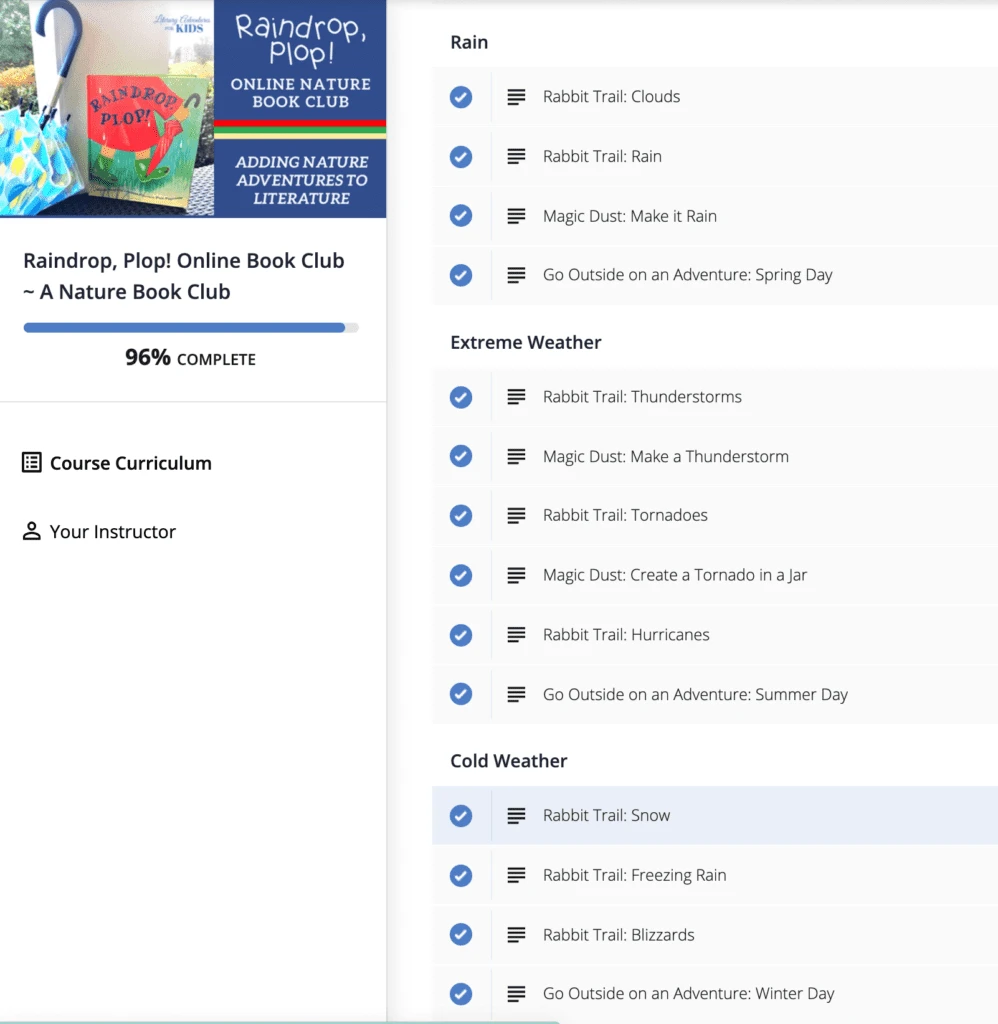
There are lots of fun things there for little kids to do. And the really fun part is at the end of every book club, you get to have a party. And this is my kids’ favorite part. As soon as we finish the book, we have a party,
We usually skip the decorations, because that’s just not something we’re really into, but we do the food. There always a list of all of the food that was eaten in the book. We’ll usually pick one or two of the things that were mentioned. For this one, we did hot chocolate and I think we might have made one of these weather-themed snacks, like clouds with raindrops.
For activities, we’ll do something from the book or related to the book. We might play a game that was mentioned. We’ll usually listen to music that has to do with the book or the time period.
In the case of Raindrop Plop! we picked our own activity. We’re really into watercolor right now, so we did watercolor rainbows. We looked at a picture online and we all sort of did our own interpretation of it.
So that’s kind of what the individual book clubs look like. Now, like I said, you can buy the individual novel studies yourself. Each one is about eight units each, and you could get through a couple of units in a week, completing about one book study per month. I think that’s sort of the idea. But you can also do it at your own pace. Sometimes we take about two months to do one of the longer books just because we’re not doing it every day.
They also have two memberships. The memberships are currently closed because they do live online book clubs, and they want to give people the chance to participate in all of those in the semester, but you can join the memberships at the beginning of each semester.
If you’re interested in that, you can get on a waitlist. They have the Literary Adventures Clubhouse and the Society of Literary Adventurers. The Society of Literary Adventurers is more for teens and includes all of your novels for older kids. They’ve mapped out a plan for how you can use this program for your four years of high school English language instruction, so that’s really cool.
They’ve done the same thing for the Literary Adventures Clubhouse, which is for elementary school and middle school students.
Basically, they’ve mapped out a set of books that you could do each year and cover all of your language arts with these novel studies. Because it’s not open right now, I can’t tell you the exact price on this. I want to say it’s about $35 per quarter. So, it works out to about the same price as buying one novel study a month, a little bit less than that. The novel studies are on the more expensive side of the price range, so if you’re planning to do two or more, I definitely recommend grabbing the membership.
Our family has the Literary Adventures Clubhouse subscription and we love it. It’s so much fun for our kids. We’re getting a lot of great books read and doing fun activities without having to do any prep. So, if you want to check that out, go to literaryadventuresforkids.com.
Depending on the ages of your kids, you might be interested in either the Literary Adventures Clubhouse or the Society of Literary Adventurers. Or you might just want to check out one novel study at a time and you can do that too by purchasing them individually.
If you have any questions, just drop them below, and I would be happy to answer them. Have a great day. And thanks for watching.
Need more information about Literary Adventures for Kids?
Check out my previous review: Online Book Clubs for Kids (Perfect for Homeschoolers)
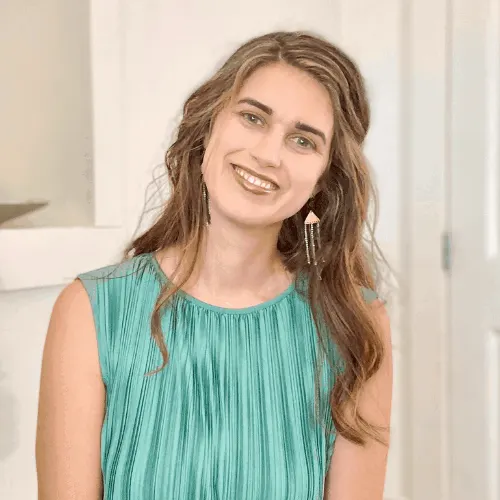
Sophie Agbonkhese is a writer, homeschooling mother of four, and a recovering overachiever (who occasionally relapses). She is the founder of My Cup Runs Over, a site dedicated to helping busy women simplify and enrich their lives. When she’s not writing or debugging websites, Sophie spends her time reading, dancing, bullet journaling, reading, gardening, listening to audiobooks, and striving fruitlessly to have a clean house for at least five minutes.

